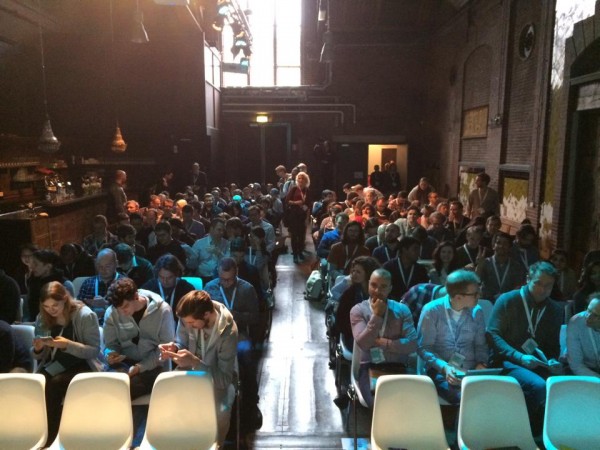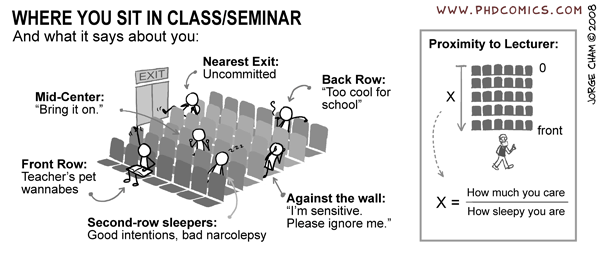The mystery of the front row

Wherever lectures happen, regardless of the size of the venue, most of the front row will be empty. Even when the lecture hall is standing room only (should we be so lucky), many of the seats up front will be vacant. In this photo you can see people standing, looking for seats, but not venturing towards the front.
Now at a rock concert, or sporting event, people would sell their children to get a front row seat. The only time I had front row seats at a basketball game it cost me $300 and I had to watch two bad teams: it was just too expensive to get great seats to see excellent teams.
The front row is almost always empty because:
- We like the freedom to be bored. In the front, there’s nowhere to hide. If we want to nap, pick our nose, read e-mail, we can’t without feeling embarrassed. If the speaker is bad, we’re stuck, for an hour or more, in living hell.
- We’re taught in school to go for the back. People in the front get called on by teachers. Most of us hated that experience, so we hide ourselves in the middle rows.
- We have low confidence in public speakers. We’re doubtful it’s going to be good, and we want the option to leave quickly without embarrassing ourselves.
- The front row feels like part of the show. Sitting within a few feet feels like you are on stage yourself, a feeling most people don’t like. Some people also fear being picked as a volunteer which seems more likely in the front.
- No one can see from the back that the front seats are empty. Unless the organizers, or the speaker, actively helps people find the best seats, the audience might not even know they’re available. The speaker has a much better view of the audience than the audience does.
I suppose it’s a sign of a speaker with a good reputation when people confidently sit in the risky front row.
This diagram below from cartoon phdcomics offers several other theories about where people sit. My favorite part of their analysis is the proximity to lecturer formula, that divides how much you care by how tired you are. Perhaps it would be more accurate to measure how committed you are to the speaker. If you’re 100% convinced you need to listen to the entire lecture, you want the best experience possible. If you’re not sure, or if you’re at an event with multiple tracks, you want the ability to change your mind.

How Do You Fix This Problem?
In Confessions of a Public Speaker, in chapter 4 on how to work a tough room, I explain a technique. All you have to do as the speaker is take responsibility for the room. Ask people to stand up and move. It helps to have free books or Starbucks gift cards, but with some friendly requests and motivation, people will usually do as you ask.
It’s always in the speaker’s interest to improve the room. If people are spread too thin, the room will never feel good. It’s far better to have density near the front, than people sprinkled around a very large room. People need to sit near each other, and close to the stage, to feel like an audience. And as a speaker, you want the audience to feel safe to applaud, laugh and respond to while you’re presenting.
(Photo by Paolo Malabuyo, at IXDA14)
